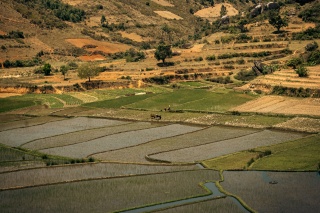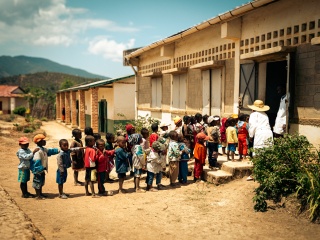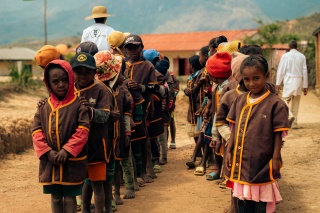
Madagascar and Kenya – connected through Mary’s Meals
Despite differences in economic progress, infrastructure and development, Madagascar has many similarities with Kenya – and we are united by Mary’s Meals’ school-feeding programme.
There’s a lake in the middle of Madagascar’s capital city Antananarivo. At 7am when we leave, people are already fishing and doing their laundry, usually with a child in tow. People of all ages are on the streets, heading to work or busy conducting business – hawking food, selling second-hand clothes and exchanging money.
Having been born and raised in Nairobi, Kenya, I experience a lot of similarities in Madagascar, but also some striking differences – from agriculture and the landscape to brick production and the Malagasy language. The people here are incredibly warm and welcoming, just like at home, but there is a distinct and unique cultural blend of African, Asian and French traditions.

Development in rural Madagascar
The natural environment in Madagascar is pristine and the air is fresh as we travel down to a Mary’s Meals feeding location in Ranomafana. The roads are generally very bad. Every time we slow down to navigate the gaping potholes, children run after the car begging for food and small change.
I am amazed by how much the land feels untouched. Unlike in Kenya where there is healthy economic progress and infrastructure, Madagascar seems to have a slower pace of development, especially in rural areas. The staple food is rice and terraced rice fields are a major part of the landscape that seem to stretch endlessly across the hills and valleys. I don’t see any farm machinery, just local farmers hip-deep in rice paddies. In Kenya, I am used to seeing mechanised farming working the flat maize and tea fields.
In rural areas traditional brick production using clay is a major economic activity. The bricks are formed and shaped by hand, lined up and dried in the sun, and then fired in open-air furnaces. It is fascinating to see how brick production shapes the landscape in Madagascar – again, similar yet so different from rural Kenya, where we use a manually operated machine called makiga to produce bricks.

Providing daily meals in places of education
In Ranomafana, we are welcomed with music and a dance by the children at Ranomafana Primary School. Jeannine is busy preparing the meal of the day for the children. As a parent who was orphaned at a very young age and didn’t get the chance to go very far in her studies, Jeannine understands the importance of education. She volunteers to help children at the school receive a hot meal and the opportunity for an education this brings. We also meet a young boy who tells us about the first day he received a meal in school and how happy he was when this encouraged more children to come to school. Receiving daily school meals, he says, takes the burden off parents having to make lunch and gives the children more time to learn at school.
Just like in Kenya, community ties are very strong in Madagascar, with a big emphasis placed on family. And like in rural areas of Kenya, parents often take their older children with them to work in the farms, which means the younger girls need to spend their days caring for younger siblings at home, instead of sitting in a classroom receiving an education. Through providing daily school meals to children at Ranomafana Primary School, Mary’s Meals eases this strain, giving children the chance to go to school.
Later in the trip, we visit Antafotenina Primary School. The head teacher speaks passionately about the impact of Mary’s Meals on school performance and how rarely children miss school since the school feeding programme began. She also mentions that the number of girls attending school has increased and that they bring their younger siblings along with them. The only reason parents send their children to school, she says, is because they know they will receive a meal – and she fears that without daily school meals the older children will go back to helping their parents earn an income and forfeit their education.

Food for thought
Back in Nairobi, I am struck by the power of school feeding initiatives such as Mary’s Meals nurture a sense of shared responsibility and hope for future generations, reinforcing the importance of education as a pathway out of poverty.
Despite our differences in economic progress and infrastructure, Madagascar has much in common with Kenya. We are both African nations with tropical climates and a significant rural population living through various stages of development – and we are also connected by our association with Mary’s Meals.
And through our mission at Mary’s Meals, I also understand how much love exists in this world – where people care for people they might never see, in places they may never go.
It costs just £19.15, €22, $25.20 USD or $31.70 CAD to provide a child with school meals for an entire school year. We currently serve daily meals to more than 88,500 children in primary schools, education centres and detention centres every school day. Your donation will help us reach more children in Madagascar – giving hope to the children and the communities they live in.
Christine Atoto is our Assistant Video Editor. She produces compelling visual content that highlights the organisation's impactful work and helped with additional filming and sound work for our film Walking Together.
